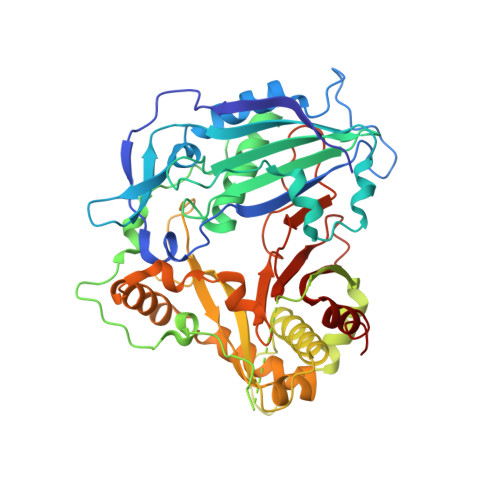Elucidation of the structure and reaction mechanism of sorghum hydroxycinnamoyltransferase and its structural relationship to other coenzyme a-dependent transferases and synthases.
Walker, A.M., Hayes, R.P., Youn, B., Vermerris, W., Sattler, S.E., Kang, C.(2013) Plant Physiol 162: 640-651
- PubMed: 23624856
- DOI: https://doi.org/10.1104/pp.113.217836
- Primary Citation of Related Structures:
4KE4, 4KEC - PubMed Abstract:
Hydroxycinnamoyltransferase (HCT) from sorghum (Sorghum bicolor) participates in an early step of the phenylpropanoid pathway, exchanging coenzyme A (CoA) esterified to p-coumaric acid with shikimic or quinic acid as intermediates in the biosynthesis of the monolignols coniferyl alcohol and sinapyl alcohol. In order to elucidate the mode of action of this enzyme, we have determined the crystal structures of SbHCT in its apo-form and ternary complex with shikimate and p-coumaroyl-CoA, which was converted to its product during crystal soaking. The structure revealed the roles of threonine-36, serine-38, tyrosine-40, histidine-162, arginine-371, and threonine-384 in catalysis and specificity. Based on the exact chemistry of p-coumaroyl-CoA and shikimic acid in the active site and an analysis of kinetic and thermodynamic data of the wild type and mutants, we propose a role for histidine-162 and threonine-36 in the catalytic mechanism of HCT. Considering the calorimetric data, substrate binding of SbHCT should occur sequentially, with p-coumaroyl-CoA binding prior to the acyl acceptor molecule. While some HCTs can use both shikimate and quinate as an acyl acceptor, SbHCT displays low activity toward quinate. Comparison of the structure of sorghum HCT with the HCT involved in chlorogenic acid synthesis in coffee (Coffea canephora) revealed many shared features. Taken together, these observations explain how CoA-dependent transferases with similar structural features can participate in different biochemical pathways across species.
Organizational Affiliation:
School of Molecular Biosciences, Washington State University, Pullman, Washington 99164, USA.
















